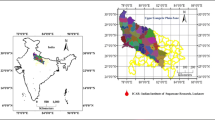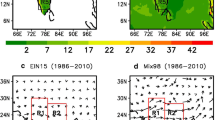Abstract
Climate modes like ENSO (El Nino Southern Oscillation) and IOD (Indian Ocean Dipole) produce an impact on the monsoon rainfall over India. Monsoon rainfall is extremely important for the agriculture of our country. The impact of these climate modes on monsoon rainfall thus in turn affects the rain-fed crops (kharif). In this study, four kharif season crops namely rice (Oryza sativa), maize (Zea mays), pulses and sugarcane (Saccharum officinarum) are chosen over four arid/semi-arid agro-climatic zones of western India to study the effect of the climate modes on selected crops. The detailed analysis has been carried out to show the impact of rainfall in the El Nino/La Nina (phases of ENSO) and IOD years on the crop productions over the mentioned zones viz. (Central plateau and hills region; Western plateau and hills region; Gujarat hills and plains region; Western dry region) from 1966–2011. The results show that rice productions which require hot and humid conditions have been largely affected during drought years associated with El Nino which results in poor rainfall over all the zones. The production of pulses which does not require excess humid conditions shows marginal improvement during the neutral years or non-El Nino/non-La Nina years. Maize production seems to be better in La Nina years and worst in the El Nino years as La Nina years are responsible for good rainfall in all zones. El Nino years provide a minor impact on sugarcane productions in different zones. La Nina years are well suited for sugarcane production in all zones of our study as sugarcane requires a good amount of moisture. Positive IOD years are associated with poor crop productions as compared to negative IOD years mostly in all zones as most of the positive IOD years happen to be El Nino years. El Nino-rainfall relation being dominant than positive IOD-rainfall relation is, therefore, responsible for negative rainfall anomalies over the selected zones.





Similar content being viewed by others
Data availability
All data generated or analysed during this study are included in this published article.
Code availability
Not required.
References
Annamalai HSPX, ** El Niño. J Clim 18(2):302–319
Ashok K, Saji NH (2007) On the impacts of ENSO and Indian Ocean dipole events on sub-regional Indian summer monsoon rainfall. Nat Hazards 42(2):273–285
Ashok K, Guan Z, Yamagata T (2001) Impact of the Indian Ocean dipole on the relationship between the Indian monsoon rainfall and ENSO. Geophys Res Lett 28(23):4499–4502
Ashok K, Guan Z, Saji NH, Yamagata T (2004) Individual and combined influences of ENSO and the Indian Ocean dipole on the Indian summer monsoon. J Clim 17(16):3141–3155
Bala I, Singh OP (2008) Relationship between Indian Ocean dipole mode and summer monsoon. Mausam 59(2):167
Behera SK, Yamagata T (2003) Influence of the Indian Ocean dipole on the Southern Oscillation. J Meteorol Soc Japan Ser II 81(1):169–177
Bhatla R, Laxmi U, Singh M (2016a) Drought/flood in relation to El Nino/La Nina over all India, East Uttar Pradesh and some station of East Uttar Pradesh. J Clim Chang 3(1):27–35
Bhatla R, Singh S, Mandal B, Singh M (2016b) Association of sea surface temperature over different Nino regions with summer monsoon rainfall over Indo-Gangetic plains. Vayumandal 42(1):21–29
Bhatla R, Varma P, Verma S, Ghosh S (2020) El Nino/La Nina impact on crop production over different agro-climatic zones of Indo-Gangetic Plain of India. Theoret Appl Climatol 142(1):151–163
Box GEP, Jenkins GM (1976) Time series analysis: forecasting and control, 2nd edn. Holden Day, San Francisco
Gadgil S (1996) Climate change and agriculture—an Indian perspective. CurrSci 69(8):649–659
Krishna Kumar K, Rajagopalan B, Cane MA (1999) On the weakening relationship between the Indian monsoon and ENSO. Science 284(5423):2156–2159
Krishna Kumar K, Rajagopalan B, Hoerling M, Bates G and Cane M (2006) Unraveling the mystery of Indian monsoon failure during El Niño. Sci 314(5796):115–119
Mohanty S, Satyasai KJ (2015) Feeling the pulse, Indian pulses sector. NABARD Rural Pulse 10:1–4
Parthasarathy BA, Munot AA, Kothawale DR (1988) Regression model for estimation of foodgrain production from summer monsoon rainfall. Agric for Meteorol 42:167–182
Rainfall Statistics of India (2016) India Meteorological Department (Ministry Of Earth Sciences) Report No. ESSO/IMD/HS/R. F. REPORT/01(2017)/23
Saji NH, Goswami BN, Vinayachandran PN, Yamagata T (1999) A dipole mode in the tropical Indian Ocean. Nature 401(6751):360–363
Samanta D, Rajagopalan B, Karnauskas KB, Zhang L, Goodkin NF (2020) La Niña’s diminishing fingerprint on the central Indian summer monsoon. Geophys Res Lett 47(2):e2019GL086237
Sardana V, Sharma P, Sheoran P (2010) Growth and production of pulses. Soils, Plant Growth Crop Prod 3:378–416
Shukla SK, Sharma L, Awasthi SK and Pathak AD (2017) Sugarcane in India: package of practices for different agro-climatic zones. AICRP (S) Tech Bull (1):1–64
Shukla SK, Zubair A, Awasthi SK and Pathak AD (2018) Sugarcane varieties identified by AICRP (S) in India. ICAR-AICRP on Sugarcane
Srivastava AK and Rai MK (2012) Sugarcane production: impact of climate change and its mitigation. Biodiversitas J Biol Divers, 13(4)
Upreti P, Singh A (2017) An economic analysis of sugarcane cultivation and its productivity in major sugar producing states of Uttar Pradesh and Maharashtra. Econ Aff 62(4):711–718
Wang B, **ang B, Li J, Webster PJ, Rajeevan MN, Liu J, Ha KJ (2015) Rethinking Indian monsoon rainfall prediction in the context of recent global warming. Nat Commun 6(1):1–9
Webster PJ, Magana VO, Palmer TN, Shukla J, Tomas RA, Yanai M, Yasunari T (1998) Monsoons: processes, predictability, and the prospects for prediction. J Geophys Res 103:14451–14510
Yuheng Y, Weng B, Bi W, Xu T, Yan D, Ma J (2019) Climate change impacts on drought-flood abrupt alternation and water quality in the Hetao Area, China. Water 11:652. https://doi.org/10.3390/w11040652
Acknowledgements
The author wants to thank Indian Institute of Tropical Meteorology (IITM, Pune) for providing the rainfall data required in the study, NOAA, Climate Prediction Centre for ONI data and NOAA, Physical Science Laboratory for DMI data and thank Bureau of Meteorology (BOM) for positive and negative IOD year’s data. The author also wants to thank International Crops Research Institute for Semi-Arid Tropics (ICRISAT-IN) for providing crop production data.
Funding
This project was funded by the Department of Science and Technology (DST), Ministry of Earth Science (MoES), Govt. of India in the form of the Centre for Excellence in Climate Change.
Author information
Authors and Affiliations
Contributions
R.B. helps in the conceptualisation of the study. S.B. and S.V. have analysed the data and provide methodology. R.K.M. and R.S.S. have guided in the agriculture section, review and editing of the manuscript. S.G., S.V. and R.B. completed the writing of original manuscript of the paper.
Corresponding author
Ethics declarations
Ethics approval
For this type of study, formal approval is not required.
Consent to participate
For this type of study, formal consent is not required.
Consent for publication
For this type of study, consent for publication is not required.
Conflict of interest
The authors declare no competing interests.
Additional information
Publisher's note
Springer Nature remains neutral with regard to jurisdictional claims in published maps and institutional affiliations.
Rights and permissions
Springer Nature or its licensor (e.g. a society or other partner) holds exclusive rights to this article under a publishing agreement with the author(s) or other rightsholder(s); author self-archiving of the accepted manuscript version of this article is solely governed by the terms of such publishing agreement and applicable law.
About this article
Cite this article
Bhatla, R., Bhattacharyya, S., Verma, S. et al. El Nino/La Nina and IOD impact on Kharif season crops over western agro-climatic zones of India. Theor Appl Climatol 151, 1355–1368 (2023). https://doi.org/10.1007/s00704-023-04361-z
Received:
Accepted:
Published:
Issue Date:
DOI: https://doi.org/10.1007/s00704-023-04361-z




